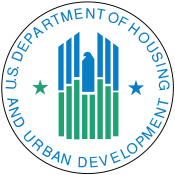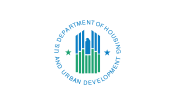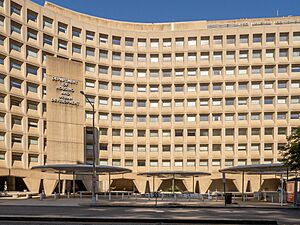United States Department of Housing and Urban Development facts for kids

Seal of the U.S. Department of Housing and Urban Development
|
|

Flag of the United States Department of Housing and Urban Development
|
|
 Robert C. Weaver Federal Building, Department Headquarters |
|
| Agency overview | |
|---|---|
| Formed | September 9, 1965 |
| Preceding agency |
|
| Jurisdiction | Federal government of the United States |
| Headquarters | Robert C. Weaver Federal Building 451 7th Street SW, Washington, D.C. 38°53′2.17″N 77°1′21.03″W / 38.8839361°N 77.0225083°W |
| Employees | 7,240 (FY2021 FTE) |
| Annual budget | $60.3 billion (FY2021) |
| Agency executives |
|
| Key document |
|
The United States Department of Housing and Urban Development (HUD) is an important part of the U.S. federal government. It helps make sure people have good homes and live in strong communities. HUD creates and carries out laws about housing and city development.
The leader of HUD is called the Secretary of Housing and Urban Development. This person works closely with the president of the United States and is part of the president's main team, called the Cabinet. HUD was started in 1965 as part of President Lyndon B. Johnson's "Great Society" plan. This plan aimed to improve life for all Americans.
Contents
How HUD Started and Grew
The idea for a department like HUD began in 1957. People thought the government should have a special group to focus on cities. President John F. Kennedy also liked this idea. He saw it as a top goal for his government.
Becoming a Cabinet Department
HUD officially started on September 9, 1965. President Lyndon B. Johnson signed a law to create it. The department was set up to help with housing and city problems. Its main office is in the Robert C. Weaver Federal Building.
Important Steps in HUD's History
Over the years, HUD has taken many steps to help people. Here are some key moments:
- 1934: The Federal Housing Administration was created. It helps people get loans to buy homes.
- 1937: The United States Housing Authority was formed. It worked to clear out poor neighborhoods and build affordable homes.
- 1938: The Federal National Mortgage Association (FNMA) was started. This group helps make sure there's enough money for home loans.
- 1949: The Housing Act of 1949 aimed to get rid of slums and improve communities.
- 1965: HUD was officially made a Cabinet-level agency. This meant it became a very important part of the government.
- 1968: The Fair Housing Act was passed. This law made it illegal to treat people unfairly when they try to rent or buy a home. It stopped discrimination based on race, religion, and other factors.
- 1968: The Government National Mortgage Association (Ginnie Mae) was created. It helps make housing more affordable.
- 1969: The Brooke Amendment was added. It said that low-income families should not pay more than 25% of their income for rent.
- 1974: The Housing and Community Development Act of 1974 helped cities get money for community projects.
- 1987: The Stewart B. McKinney Homeless Assistance Act was passed. It helps communities deal with homelessness.
- 1992: The HOPE VI program began. It aimed to improve public housing.
- 1998: HUD opened an Enforcement Center. This center makes sure that people who get HUD money follow the rules.
- 2000: More Americans owned their homes than ever before.
- 2013: HUD had to close its offices on some days due to budget cuts.
How HUD is Organized
HUD has different parts that work together. These parts include various agencies, offices, and a special corporation.
Main Agencies and Offices
- Federal Housing Administration: Helps people get home loans.
- Center for Faith-Based and Neighborhood Partnerships: Works with community groups.
- Departmental Enforcement Center: Makes sure rules are followed.
- Office of Community Planning and Development: Helps communities grow and develop.
- Office of Fair Housing and Equal Opportunity: Works to stop housing discrimination.
- Office of Healthy Homes and Lead Hazard Control: Focuses on making homes safe and healthy.
- Office of Public and Indian Housing: Manages housing programs for public and Native American communities.
- Government National Mortgage Association (Ginnie Mae): Helps make housing more affordable.
Major Programs HUD Manages
HUD runs several big programs to help people and communities:
- Community Planning and Development: This group handles programs that help with affordable housing and homelessness. It includes grants for community projects and aid for people with AIDS.
- Housing: This office oversees the Federal Housing Administration. It also helps manage housing for the elderly and people with disabilities.
- Public and Indian Housing: This part of HUD manages public housing programs. It also helps Native American tribes with their housing needs. The Housing Choice Voucher Program is managed here.
- Office of Fair Housing and Equal Opportunity: This office makes sure that federal laws against discrimination in housing are followed. They protect people based on their race, religion, and other factors.
- Policy Development and Research (PD&R): This office gathers information about housing needs. It also does research to find solutions for housing and community problems.
- Government National Mortgage Association, or Ginnie Mae: This group helps make housing loans available and affordable.
- Healthy Homes and Lead Hazard Control: This program works to make homes safer, especially by dealing with lead paint.
Office of Inspector General
The Office of Inspector General (OIG) is a special part of HUD. It was created by the United States Congress to make sure that HUD works honestly and efficiently.
What the OIG Does
The OIG's main jobs are:
- To make sure HUD's programs are fair, effective, and efficient.
- To find and stop waste, fraud, and abuse of money in HUD programs.
- To take action against anyone who misuses HUD funds.
The OIG does this by doing investigations and audits. They also keep Congress and the public informed about their work. The current Inspector General is Rae Oliver Davis.
See also
 In Spanish: Departamento de Vivienda y Desarrollo Urbano de los Estados Unidos para niños
In Spanish: Departamento de Vivienda y Desarrollo Urbano de los Estados Unidos para niños

